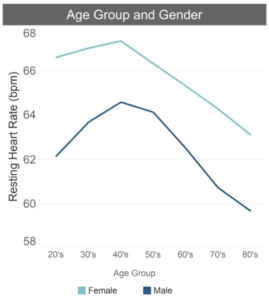Matters of the Heart: Why You Should Know Your Resting Heart Rate
At the recent HIMSS 2019 medical conference, Dr. Karl Poterack, Medical Director of Applied Clinical Informatics at the Mayo Clinic, said that clinicians often don’t take the time to utilize health data collected from a person’s wearable fitness device. But he noted that having resting heart rate (RHR) information can be useful–especially for the patient, who can use their digital data to monitor their heart health and alert doctors to changes.
So in our continuing focus on matters of the heart for February’s American Heart Month, let’s follow Dr. Poterack’s orders and learn more about RHR, why it is important to track, what factors can alter it, and how everyone in the family (no matter what age) can improve overall heart health with exercise. Tracking your real-time heart data, including changes in your resting heart rate, just might save your life. Here are seven resting heart rate facts and stats:
Know your numbers. The ability to track resting heart rate with Fitbit devices allows you to know if your resting heart rate falls within an “average” range. The American Heart Association notes that a normal resting heart rate ranges from 60 to 100 beats per minute (bpm) for adults. Medical experts also agree that a lower resting heart rate can indicate more efficient heart function and cardiovascular fitness, as highly conditioned athletes typically have a resting heart rate of 40 to 60 bpm.
RHR changes with age. Fitbit has tracked more than 108 billion (yes, billion!) hours of heart rate data from 4 million active users. So with one of the most extensive, longitudinal databases on heart rate metrics in the world, Fitbit data provides interesting insights, including this: male and female users’ RHR increased with age from 20s to the 40s, then decreased after age 40.

Resting heart rate data analysis by age and gender (Graphic: Business Wire)
Women typically have higher RHRs. The same Fitbit data analysis also shows the differences in resting heart rate by gender. Women have a higher average RHR than men by about 3 beats per minute (BPM). Women ages 40-49 have the highest average RHR of all users at 67.4 BPM, while men ages 40-49 have the highest average RHR among males at 64.6 BPM.
Be aware of the factors that can affect your heart rate. Chronic sleep deprivation—which can lead to fatigue, a lower metabolism, and extra snacking—can raise the RHR. So aim for at least seven hours of sleep each night. Prolonged stress can also cause resting heart rate to creep up, and the associated increase can result in a higher risk of heart attacks and stroke. Other factors that affect your resting heart rate are: air temperature (high temps and humidity can increase pulse), body position (BPMs can go up right when you stand up), and medication, such as beta blockers that block adrenaline and can slow the pulse.
Weight plays a part. Fitbit data shows a correlation between RHR and Body Mass Index (BMI). Weighing too much or too little can elevate a person’s resting heart rate. Body size doesn’t have a huge impact on pulse overall, but if a person is obese, they might see a higher resting pulse than normal, but usually not more than 100.
Improve RHR with endurance exercise. While not one exercise can magically reduce your resting heart rate, some are better than others for improving heart health. Walking is sometimes considered to be the “superfood” of fitness. In a report that included findings from multiple studies, Harvard Medical School found that walking reduced the risk of cardiovascular events by 31 percent and cut the risk of dying by 32 percent, with the benefits being equal in men and women. The benefits were evident even at distances of only 5.5 miles per week and at a casual pace of about 2 miles per hour.
Some experts recommend that intervals and high-intensity exercises such as swimming and cycling are an efficient way to change RHR numbers. In general, aim for 30-40 minutes of heart-elevating exercise at least four days a week. One study that involved 55-year-old adults found that just one hour per week of high-intensity aerobic training (about 66 percent of maximum effort) lowered RHR more efficiently than a low-intensity effort (33 percent of max effort).
Healthy heart habits start when a person is very young. Heart rates for kids can be as low as 60 bpm during sleep and as high as 220 bpm during strenuous physical activity, while athletic kids have slower resting heart rates, typically 40-50.
Staying active is one of the most important ways—for adults and for kids—to maintain a normal resting heart rate. The American Heart Association recommends that kids and teens (ages 6-17) get at least 60 minutes of moderate to vigorous physical activity every day. While kids can get bored in a millisecond on an elliptical or rowing machine, their interest could last for hours on a kayak trip, family bike ride or hike (add a hill or two), or beach walk.
Another rock-solid plan might be to take the family (or the office workgroup) on an amusement park adventure. Full disclosure: The day after hearing Dr. Poterack’s heart data lecture at HIMSS, I used my Fitbit Versa to accurately track my Disney Animal Kingdom activity–6.15 miles–along with the meteoric rise in my heart rate (104 BPM) during the 3D mountain banshee ride in Pandora. So take Dr. Poterack’s advice to heart: watch your daily data, and take steps to help get your heart in shape.
